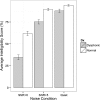The Effect of Background Noise on Intelligibility of Dysphonic Speech
- PMID: 28679008
- PMCID: PMC6194928
- DOI: 10.1044/2017_JSLHR-S-16-0012
The Effect of Background Noise on Intelligibility of Dysphonic Speech
Abstract
Purpose: The aim of this study is to determine the effect of background noise on the intelligibility of dysphonic speech and to examine the relationship between intelligibility in noise and an acoustic measure of dysphonia: cepstral peak prominence (CPP).
Method: A study of speech perception was conducted using speech samples from 6 adult speakers with typical voice and 6 adult speakers with dysphonia. Speech samples were presented to 30 listeners with typical hearing in 3 noise conditions: quiet, signal-to-noise ratio (SNR)+5, and SNR+0. Intelligibility scores were obtained via orthographic transcription as the percentage of correctly identified words. Speech samples were acoustically analyzed using CPP, and the correlation between the CPP measurements and intelligibility scores was examined.
Results: The intelligibility of both typical and dysphonic speech was reduced as the level of background noise increased. The reduction was significantly greater in dysphonic speech. A strong correlation was noted between CPP and intelligibility score at SNR+0.
Conclusions: Dysphonic speech is relatively harder to understand in the presence of background noise as compared with typical speech. CPP may be a useful predictor of this intelligibility deficit. Future work is needed to confirm these findings with a larger number of speakers and speech materials with known predictability.
Figures



Similar articles
-
Predicting Intelligibility Deficit in Dysphonic Speech with Cepstral Peak Prominence.Ann Otol Rhinol Laryngol. 2018 Feb;127(2):69-78. doi: 10.1177/0003489417743518. Epub 2017 Dec 10. Ann Otol Rhinol Laryngol. 2018. PMID: 29224360 Free PMC article.
-
The Effects of Dysphonic Voice on Speech Intelligibility in Cantonese-Speaking Adults.J Speech Lang Hear Res. 2021 Jan 14;64(1):16-29. doi: 10.1044/2020_JSLHR-19-00190. Epub 2020 Dec 11. J Speech Lang Hear Res. 2021. PMID: 33306439
-
Perception and Acoustic Studies of Vowel Intelligibility in Dysphonic Speech.J Voice. 2021 Jul;35(4):659.e11-659.e24. doi: 10.1016/j.jvoice.2019.12.022. Epub 2020 Jan 15. J Voice. 2021. PMID: 31952898
-
The Formant Bandwidth as a Measure of Vowel Intelligibility in Dysphonic Speech.J Voice. 2023 Mar;37(2):173-177. doi: 10.1016/j.jvoice.2020.10.012. Epub 2020 Nov 2. J Voice. 2023. PMID: 33143999
-
Agreement between Transcription- and Rating-Based Intelligibility Measurements for Evaluation of Dysphonic Speech in Noise.Clin Linguist Phon. 2021 Oct 3;35(10):983-995. doi: 10.1080/02699206.2020.1852602. Epub 2020 Nov 29. Clin Linguist Phon. 2021. PMID: 33251880
Cited by
-
The Effect of Breathy Vocal Quality on Speech Intelligibility and Listening Effort in Background Noise.Trends Hear. 2023 Jan-Dec;27:23312165231206925. doi: 10.1177/23312165231206925. Trends Hear. 2023. PMID: 37817666 Free PMC article.
-
Combining degradations: The effect of background noise on intelligibility of disordered speech.J Acoust Soc Am. 2018 Jan;143(1):281. doi: 10.1121/1.5021254. J Acoust Soc Am. 2018. PMID: 29390797 Free PMC article.
-
Pareto-Optimized Non-Negative Matrix Factorization Approach to the Cleaning of Alaryngeal Speech Signals.Cancers (Basel). 2023 Jul 16;15(14):3644. doi: 10.3390/cancers15143644. Cancers (Basel). 2023. PMID: 37509305 Free PMC article.
-
A lecturer's voice quality and its effect on memory, listening effort, and perception in a VR environment.Sci Rep. 2024 May 30;14(1):12407. doi: 10.1038/s41598-024-63097-6. Sci Rep. 2024. PMID: 38811832 Free PMC article.
-
Hey Siri: How Effective are Common Voice Recognition Systems at Recognizing Dysphonic Voices?Laryngoscope. 2021 Jul;131(7):1599-1607. doi: 10.1002/lary.29082. Epub 2020 Sep 19. Laryngoscope. 2021. PMID: 32949415 Free PMC article.
References
-
- Adams S., Dykstra A., Jenkins M., & Jog M. (2008). Speech-to-noise levels and conversational intelligibility in hypophonia and Parkinson's disease. Journal of Medical Speech-Language Pathology, 16, 165–172.
-
- Awan S. N., Roy N., Jetté M. E., Meltzner G. S., & Hillman R. E. (2010). Quantifying dysphonia severity using a spectral/cepstral-based acoustic index: Comparisons with auditory-perceptual judgements from the CAPE-V. Clinical Linguistics & Phonetics, 24, 742–758. - PubMed
-
- Baken R. J., & Orlikoff R. F. (2000). Clinical measurement of speech and voice. Boston, MA: Cengage Learning.
-
- Benninger M. S., Alessi D., Archer S., Bastian R., Ford C., Koufman J., … Woo P. (1996). Vocal fold scarring: Current concepts and management. Otolaryngology—Head and Neck Surgery, 115, 474–482. - PubMed
-
- Bickley C. (1982). Acoustic analysis and perception of breathy vowels. Speech Communication Group Working Papers, 1, 71–81.
MeSH terms
Grants and funding
LinkOut - more resources
Full Text Sources
Other Literature Sources
Medical

